Tripura is one of the third smallest states of India, with boundaries of the state meet Assam and Mizoram and the international borders meet Bangladesh. Tripura is also included in seven sister states along the North-Eastern border of India. Agartala is the capital of Tripura.
Tripura Traditional Costumes are very simple. The North-Eastern states influence a lot on the tradition and culture of Tripura. Here the people follow the similar tradition and wearing clothing styles of other north-eastern states. But the outfits are totally different and designs and patterns also quite different from other states of India. Generally, Tripura is a hilly area surrounded by natural beauties. Here the weavers very experienced and very experts to create stunning designs on the clothes. They are very talented to weave the dresses for kids, youngsters and elders. Tripura region contains various group of Tribes; the main tribes are Lushei, Khakloo, Kuki-Chin, and Hallam. These tribes weave their traditional outfits.
COUSTUMES OF MEN AND WOMEN

WOMEN’S COUSTUME
There are three parts of cloths used by Tripuri women, these are-RIGNAI, RIKUTU, RISA.
Rignai

It is the cloths used for covering lower half of the body. It’s meaning is to wear, and the Indian sari has evolved out of this rignai. There are many varieties of design, almost every rignai is a design. During the time of Maharaj Subrai or Trilochana, he made invented almost 240 designs of Rignai. Most of today’s rignai design are made long 4000 years back. It’s standard length is 1.6m and breadth is 1.2m. It is made according to height of lady it would wear. It is woven into 3.2m long, which is cut in two equal size then stitched side by side to make it 1.2m width.
Some of the designs are viz. Chamthwibar, mikhunchok, takhumtwi, khaklubar, kuwaifang, etc. In old days a woman’s IQ used to be judged by her woven design of rignai. It was an indication of her intelligence and her future prospect of as wife and her woman hood as a whole.
Uses Of Ringai
- Rignai is used as women dress for lower part of body.
- It is used as CHANDUA in different occasion, like wedding, betrothal, shraddha etc. Chandua is spread just in front of the foot step of main gate of home, hanged by four poles just above the head level making dome down side.
- It is used as mat or carpet when some guest visits home.
- It is in Puja or worship to place offers for god.
- It is also used as bed sheet for young people.
Rikutu
It is the garment used for part of body of Tripuri women. It covers almost whole of the body. There are different procedure to wear a Rikutu among Tripuri women. One is that it can be worn rapping around whole of the body, which is used during winter season. Other way is to use like ‘Chunri’ folding over the chest covering the bosom, both end hanging down the shoulder to the back. Another way is to rap around upwards from waist through back to front passing below the armpit in anti-clockwise then covering the chest it is hanged down over the left shoulder. It is like Pallu of Indian sari, which itself was modified version of this Tripuri rignai and Rikutu. Rituku is also worn to cove the head of women specially who are newly married.
Variety of Rikutu: In the past only few colors of rituku were available, at present Rikutu is woven to match the rignai, so it looks almost continuation of rignai. At time it becomes difficult to differentiate a women whether she is wearing a rignai or sari.
Uses Of Rikutu
- It’s main purpose is cover up the ladies upper half of the body.
- It is used a shawl in winter.
- Rikutu is used as Chandua in different occasion.
- It is used to cover up the head.
Risa
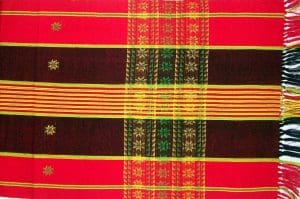
It is used to cover the breast of women. It can be equated with bra of modern women. The risa is turned around the chest so that front part of chest is covered by two layers of both end of risa. It is about 1.5m long and 0.3-0.5m width. It covers from top of chest to half way between xiphisternum and umbilicus. Risa has different designs, these are so beautiful that one forgets to blink to look at risa. Some of the designs are kwchak pali kosompali, takhumtwi, khamjang etc. There was an occasion among Tripuri people to celebrate the adolescent ceremony of girl child, known as ‘RISA SORMANI’ panda. On this day 12-14 years girls were first given risa to wear and all the relatives, near and dear one gather, do worship a Lampra god, and wish for her wellbeing for rest of life. There used to be gala feast, grandparents and brother and sister in-laws of the girl would have fun and dance with whole of the community.
Uses Of Risa
- Risa’s main use was to cover the chest of women.
- It is also used in Garia Puja, in which some paddy, cotton ball, durba grass, coin, flowers puffed rice are tied by one end of risa and other end is tied on the Garia deity of Bamboo pole.
- It is used for head turban by male folk, specially in occasion like festivals, marriages, etc.
- It is also used for tying the waist over the dhuti. It gives strength and indicates the status of person.
- Risa is also used like muffler in winter season, raping around the neck.
- It is also used as head scarf by young girls and boys in the winter.
- Risa is used to hold baby, either in front or back by women or by young children. It is very convenient an appropriate to hold by risa.
- Now a days risa is offered as mark of honour to distinguished gests in any formal occasion, ceremony
- etc. It is hanged down over the both side of shoulder in front of body.
MEN’S COSTUME
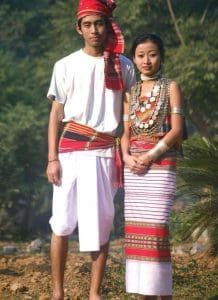
Male counterpart used to wear ‘rikutu’ for the loin and ‘kamchwlwi borok’ for the upper part of the body. But in the modern age very few people are wearing these dress except in the rural Tripura and working class. The male have adopted the modern dress of international style gaffa.
WEDDING COSTUMES IN TRIPURA

Tripura has managed to recreate the magic of traditions and culture through the medium of its folklore. The occasions, celebrations and social gatherings which take place in this state conveys a sense of originality coated with extensive layers of traditionalism. The culture of Tripura is mainly inspired by the essence of Bengal. The Bengali population covers a major portion of this state. Hence even the historical eras drew inspirations and were admirers of the Bengali culture.
Weddings are truly a visual delight in Tripura as they are deeply embedded in old age traditions which have maintained their own charm, while new innovations and ideas have given it a new and unique ethnicity of its own kind.
Style And Attire

The marriages which take place in this state solely follow the system of Hamjwk Tubui Kaimani, wherein the bride and the groom have no say or decision in finalizing their weddings. The elder members of the family take over the deciding responsibility and follow the rites and rituals of the marriage ceremonies which is a mandate for the state residents.
he wedding costumes which are donned by the men and women are ethnically woven and embroidered suiting the special occasion. The brides go in for large sized garments which go up to the knees and go across the waist called the Rinai. There involves another shorter piece of cloth which is also worn by the bride known as Risa. This colorful piece of fabric generally defines the upper portion fabric which masks the entire portion of the chest in a very ethnic way.
This upper portion of the garment also passes under the arm regions. Beautifully woven designs, floral patterns and brocaded embroideries define the elegance and beauty of Risa. Jewelry like earrings, necklaces, armlets and bangles that are worn on the wedding days are artistically made of copper, bronze, silver and other pure metals with the most common design being that of a coin. Varied coins and beads are strung together into exotic neck sets as well as delicate and colorful flowers that are chosen as ornaments.
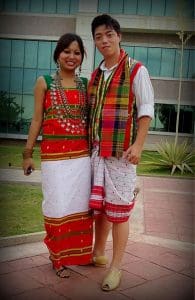
Present Day Scenario
Today’s day and age has involved a lot of innovations, transformations and preferences in their dressing tastes and lifestyles. The younger generations of today opt for clothing that is high on comfort and convenience. For instance, young brides with every passing generation prefer to go in for user friendly and comfortable blouses instead of Risa, which is a traditional garment and is considered a must for all wedding occasions in the previous years. Nowadays ethnic sarees and salwar suits are preferred by the youth of today. Fabrics which are blended in silk as well as cotton are now generally chosen by people for their wedding outfits as well as for everyday usage.
HANDLOOMS WEAVING IN TRIPURA
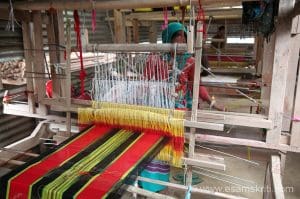
Handloom weaving is an important craft in Tripura. Tripuri women in the rural households prefer to weave their own risa and rinai which are part of their traditional dress. Other handloom products which are woven include lungi, sari, chaddar, and scarves. The motifs are different and one can identify whether it is woven by the Chakma, Kuki, Lussai or Reang tribes. The main feature of Tripuri handlooms is vertical and horizontal stripes with scattered embroidery in different colours. The artistic handloom industry is concentrated in a number of places in the rural areas, in the sub-divisions of Sadar, Sonamura, Khowai, Kailasahar and Belonia.
The Lion Loom is used for weaving. These age old looms are simple, cheap and easy to operate. They have no permanent fixtures or heavy frames and are easily portable. Also these looms offer an unlimited scope for designs. The weaver sits with a loom fixing the back strap, with her legs on the footrest, which is adjustable for keeping the loom stretched. The weaving in the lion loom requires the shedding motion, the picking motion and the beating motion. While one bar is lifted with the left hand, the circular bamboo one is pressed down with right hands imultaneously. The sword is then placed in the shed and kept vertical and the weft is passed from the right side with the right hand by means of the shuttle (a bamboo piece ship containing yarn) and picked with the left hand. The weft is then beaten up by the sword. The sword is then taken out and the centershed are produced through which the shuttle is passed
by the left hand and is picked up by the right hand. The sword is then again placed to beat the weft.

Today the handloom industry plays a vital role in the economy of the state and provides a secondary means of employment and income to indigenous cultivators. Popular handloom items which are being woven include the lasingphee (a quilt like weave in which the cloth is wadded with cloth during weaving), scarves, bedspreads, cotton saris and shoulder bags. Tablemats, cushion covers and canvas for holding chairs are also now made from woven tribal fabrics.
In Tripura, the loin loom is used for weaving. These age-old looms are simple in construction and easy to operate. They are cheap too. They have neither permanent fixtures nor heavy frames and so are easily portable. Materials and tools necessary for weaving consist of cotton, spindle, spinning machine, bow and a simple tension loom. These days the basic raw material used is acrylic, cotton and sometimes silk. Most of the yarn comes from Assam, Bengal and Southern India. Traditionally the yarn used was cotton, which was cultivated in the jhoom fields, hand spun and natural dyed by the weavers themselves. But the weavers have gradually shifted from cotton to acrylic yarns. This shift is due to various factors such as non-availability of good quality cotton, durability and wash-fastness of the acrylic yarns, all of which has made acrylic the preferred yarn type for weaving.
TRIBES OF TRIPURA
Bhil

Bhills are considered as one of the oldest tribe in India. Once they were the ruler in parts of Rajasthan, Gujarat, Malwa, Madhya Pradesh and Bihar. They are a cross section of great Munda race and a wild tribe of India. Bhills could be identified as one of the Dravidian racial tribe of Western India and belong to Austroloid group of tribes. They speak a language of Dravidian origin. In Tripura total Bhill population is 2,336 as per 2001 Census. This tribe has migrated to Tripura from central India mainly from Bihar and Madhya Pradesh. Their economy is centralized with Tea garden, Brickfield and Agriculture. Their major concentrations in Tripura are mainly in Akinpur of Belonia, Bagan Bazar of Khowai Sub-Division. They are also found in North Tripura working in Tea gardens.
Bhutia

Bhutias are Himalayan tribe and negligible in Tripura. They are similar to that of Lepchas in terms of racial identity, Linguistic affinity and religious activities. In Tripura Bhutias once were used to be engaged in the Royal Army for their warrior character and physical strength. But in course of time they left Tripura to their original homeland. Presently under 2001 Census they are only 29 persons in Tripura. Most of them in Tripura are in Govt. job like paramilitary. Few families are however permanent residents of Tripura. Their relatives also reside outside the State.
Chaimal

Chaimal is a smallest tribal group of Tripura. As per 2001 Census, their total population is only 226 persons. Their main concentration is at Ambassa of Dhalai District. They call themselves as “Saimar”.
Chaimals belong to the Cocaso-Mongoloid origin. They speak in a language originated from Kuki-Chin group of language. Chaimal language has no difference with that of Halams. They can understand and speak Kok-Borok, Chaimal live on Jhum cultivation as well use plain land cultivation.
They are Hindus and follow all rites and rituals as per Hindu customs. Due to modern weave of life, some literate persons of this community have taken Christianity as their religion. Like other tribes, they have separate form of dance, folk songs and music though performances are very occasional.
Chakma

Chakmas are one of the major tribes of Tripura according to their population strength. Chakmas are known to be a tribe of South-East Asia. They have first migrated to Arakan Hills of Bruma and then Chittagong Hill Tracts to Tripura. A major part of them however migrated to Mizoram and Arunachal Pradesh in course of time from their original homeland.
Economic activities of Chakmas are centralized with jhum cultivation, plain land cultivation and economic supporting works of vegetable growing. Fishing and wage earning. Chakmas are also ex-pert in trapping animals. They are well known for trapping wild elephants. In Tripura, especially in Gandacherra, a large number of Chakmas live as fisherman and also as boatman in Dumbur water areas.
Garo

Basically Garos are one of the immigrant tribe in Tripura. Their original homeland were at Meghalaya (Garo Hills), Kamrup, Goal Para etc. places of Assam and Mymansing of Bangladesh. Migration of this tribe took place during the 1st half of 19th Century. Their major migration took place after 1950. At present their population is 11,180 in Tripura. Their major concentrations are at Udaipur Sub-Division and Sadar Sub-Division of Tripura. Ethnically Garos are a tribe of Tibeto-Burman linguistic family and under Mongoloid racial stock. They are very much familiar with the tribes like Bodo-Cacheries, Ravas, Mikir and other North-East tribes.
Halam

Ethnically Halam belong to the Cocase-Mongoloid origin of Kuki-Chin tribes. Their language is also more or less similar to that of Tibeto-Burman family. Halams are also known as Mila Kuki, though they are not at all Kukis in terms of language, culture and living style. Halams are divided into several sub-clans which is referred as “Barki-Halam”.
Halams are basically Hindus and followers of Sakti-cult though Vaishnavism is spreading among some of the sub-clans like Murasingh, Rupini and Kaloi. But Christianity is also being embarrassed by Halams.
Halams major concen tration are in Kamalpur, Sadar East, Molsom Bari and Kwipilong of Udaipur, Ampi, Ambassa etc. places of different Sub-Divisions. Among Halams Kolai, Murasing, Rupini speak in Kok-Borok and their social and religious culture also similar with Tripuris.
Jamatia
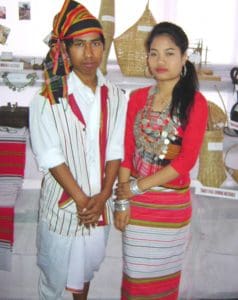
Jamatia is another tribal group of Tripura, having distinct feature of Mongoloid Origin. Their language is also similar with that of Tripuris. So they speak in Kok-Borok, which is a language of Tibeto-Burman family. As per 2001 Census their population in Tripura is 74,949 and treated as 4th largest tribal group of Tripura.
Jamatia were the major strength of Royal Army of Tripura kingdom for which they were exempted from the house taxes during princely- state. Earlier Jamatias had to live on Jhum Cultivation. But among the tribals of Tripura they accustomed themselves with plough cultivation after the Tripuris. At present most of them depend on plain land cultivation beside allied economic activities.
Khashia
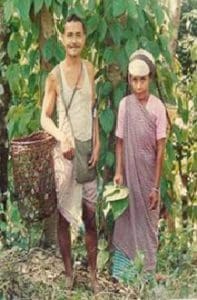
Khasias belong to Austro-Asiatic racial stock and their language could be grouped under Mon-Kher groups of language. They are famous for their matrilineal society.
Socially Khasias are Meghalayan tribe. In Tripura they are only 630 persons as per 2001 Census. They live mainly at Kailashahar and Dharmanagar. In true sense, Khasis have no ethnic relation with other Tripura tribes. They are staying here from 18th Century for economic reason. The Khasis in Tripura have their own garden of Betal leaf, which is popularly known as “Khasia Pan”. Other than this plantation work they used to rear large number of cattle.
By religion, Khasis were Hindus but from last part of 18th Century most of them embarrassed Christianity and follow the religious activities beside their amnesic rites and rituals. Their cultural life also has an important component of Indian Culture.
EMBROIDERY OF TRIPURA
Nakshi Kantha

Nakshi kantha, a type of embroidered quilt, is a centuries-old Bengali art tradition of the Bengal region in the eastern part of the Indian subcontinent, notable in Bangladesh and Indian states of West Bengal, Tripura and part of Assam.[1][2][3] The basic material used is thread and old cloth.
The colourful patterns and designs that are embroidered resulted in the name “Nakshi Kantha”,[6] which was derived from the Bengali word “naksha”, which refers to artistic patterns.[7] The early kanthas had a white background accented with red, blue and black embroidery; later yellow, green, pink and other colours were also included. The running stitch called “kantha stitch” is the main stitch used for the purpose.[8] Traditionally, kantha was produced for the use of the family. Today, after the revival of the nakshi kantha, they are produced commercially.
Making

Traditionally old sarees, lungis and dhotis were used to make kanthas. Kantha making was not a full-time job. Women in almost every household were expert in the art. Rural women worked at leisure time or during the lazy days of the rainy season, so taking months or even years to finish a kantha was normal. At least five to seven sarees were needed to make a standard-size kantha. Today the old materials are replaced by new cotton cloths. Traditionally the thread was collected from the old sarees. That is rarely done today.
When a kantha is being made, first the sarees are joined together to attain the required size, and then layers are spread out on the ground. The cloths are then smoothed, and no folds or creases are left in between. During the process, the cloth is kept flat on the ground with weights on the edges. Then the four edges are stitched and two or three rows of large running stitches are done to keep the kantha together. At this stage, the kantha can be folded and stitched at leisure time.
Originally, designs and motifs were not drawn on the cloth. The design was first outlined with needle and thread, followed by focal points, and then the filling motifs were done. In a kantha with a predominant central motif the centre was done first, followed by corner designs and the other details. In some types of kanthas (carpet, lik and sujni, etc.) wooden blocks were used to print the outline. The blocks are replaced today by patterns drawn in tracing papers.
Motifs
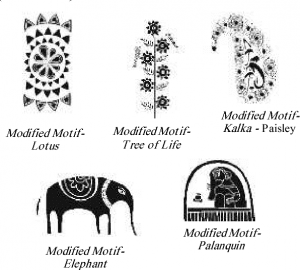
The lotus motif is the most common motif found in kanthas. This motif is associated with Hindu iconography and thus is also very popular in the kantha. The lotus is the divine seat. It is also symbolic of cosmic harmony and essential womanhood. The lotus is also the symbol of eternal order and of the union of earth, water and, sky. It represents the life-giving power of water, and is also associated with the sun for the opening and closing of the petals. It is also the symbol of the recreating power of life.

With the drying up of water, the lotus dies and with the rain it springs to life again. The lotus is associated with purity and the goddess Laksmi, the goddess of good fortune and abundance. There are various forms of lotus motifs, from the eight-petaled astadal padma to the hundred petaled satadal. In the older kanthas, the central motif is almost always a fully bloomed lotus seen from above.
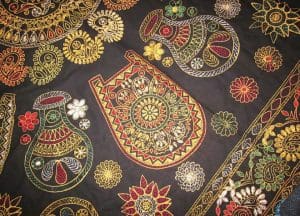
Water Motif, Mountain Motif, Fish Motif, Boat Motif, Footprint Motif, Ratha Motif, Mosque Motif, Panja or Open Palm Motif, Agricultural Implements, Animal Motifs, Toilet Articles, Kithen Implements, Kantha Motif, Palanquin Motif
ORNAMENTS WORN BY PEOPLE OF TRIPURA
Tripura Jewelry forms an important part of the tribal life of the Northeastern state. There are many kinds of tribal jewelry that are worn by the regional people in Tripura. These are very popular among the local people of the state as well as among the tourists.
The jewelry of the tribal people in Tripura are made of different kinds of metals like silver, bronze, copper etc.
Bamboo and cane Ornaments are very intricate and exquisite in nature. Bamboo and cane ornaments are not available in any other part of the country as well as abroad.
Coin Jewelries Of Tripura

The jewelries of Tripura are very unique and are crafted by local people. These jewelries are always a favorite for all tourists. The jewelries are made of mainly bronze, silver and copper. The uniqueness of these jewelries is for the coin shaped designs. Coins of metals are made to form a necklace or earrings or anklets or even headbands. The coins are being decorated with ancient cultural descriptions in art form such as picture of Lord Shiva killing the cruel King Tripur. The women prefer to wear big and heavy bangles known as “Kara” for traditional occasions.

Animal horns and bones are also used for jewelry making. The jewelry designs also encrypt the relation between man and wild. For example, a necklace made in design of the Gaur buffalo head, or headbands made from animal bones. Many also use bird feathers to decorate the head bands. The Tripura Museum shows a collection of coin jewelries with then reigning king’s or kingdom’s history was sculpted. Plane and round heavy metal necklaces are worn by the Reang women. Nowadays in many of the jewelries the face of Goddess Tripurasundari is sculpted.
Bamboo And Cane Jewelries Of Tripura

Apart from the coin jewelries, there are the handmade bamboo and cane jewelries. The village craftsmen use their art to transform bamboos into various items such as bamboo bangles, bamboo earrings, cane trendy necklaces and many other articles. The bamboo earrings are very light weight and all the bamboo jewelries come in various attractive colors also.
For Men

Tripuri men usually don’t prefer wearing jewelries. In specific occasions, some may wear metal rings along with headbands and belts made of coins. This attire looks great with the traditional costume. Occasionally men will wear a single “Kara” or bangle in one hand. Coin necklaces are also available for men in Chakma tribes.
The jewelries from Tripura are being exported throughout the country as well as abroad. The tourists who visit this North-eastern state also throngs for the shopping of tribal jewelries. This is helping to increase the financial growth curve of Tripura exponentially. Both the state and central government are looking forward to commercialize more and more the costumes and artefacts of Tripura. Visitors going to Tripura can get a collection of these jewels from the Tripura Government handloom shops or directly from the tribals in villages. Tribal jewelries of Tripura are now an evident inclusion in the “Junk Jewelries” available in all markets of our country.The native Tripuris have a lot of hope and positive attitude for their upcoming future in the country.
HANDICRAFTS OF TRIPURA
Handlooms and handicrafts of Tripura reflect the inborn art of workmanship, and uniqueness of the people. Tripura has a large population of tribals, thus has a tradition of different kinds of crafts. Handloom is the prime craft of Tripura. Intricately designed handlooms and silk, cane and bamboo works are the main form of art and craft industries. The obvious feature of Tripura handloom is vertical and horizontal stripes with distributed embroidery in multiple colours. Furniture, toys, objects of daily utility such as lamp shades, baskets, calendars, ivory work and Tripuran tribal jewellery, make shopping here a delightful experience.
Cane & Bamboo Handicrafts
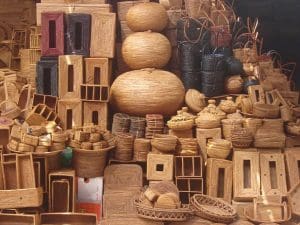
Cane and Bamboo craft are the main crafts of Tripura. Ethnic groups in Tripura make wide variety of handicraft products using bamboo and cane. Some of the well known craft produce from the State include table mats, floor mats, room dividers, decorated wall panels, attractive furniture of cane and various gift items. The handloom industry is the oldest industry in the State and artisans produce cloths with the elegant designs, unique color combinations and lasting texture. Cane and Bamboo occupy a distinctive place in the life of Tripura. Wide variety of wonderful objects is made out of the Cane and Bamboo. Variety of items are produced, including Furniture, and Table Mats & other Mat products, Lamp Shades etc.

These products are also exported to various countries as they are in great demand. Interior decoration products made out of Cane and Bamboo include ceilings, paneling, plaques, Pot containers (Planters) etc. made of Gossamer thin bamboo mattress. Lamp Shades made out of fine strips of cane and bamboo, Furniture made of cane, Baskets knitted out of cane and bamboo strips are some of the well-known craft produce from the Tripura, which are always on demand.
Rock Carving

Tucked away in the north eastern corner of the country is the state of Tripura. Rich in history, culture, and heritage, the state is also home to a number of rock carvings that decorate its hilly terrain. The rock carvings of Tripura not only accentuate its wilderness and mountainous landscape, but also stand testimony to the glorious secular culture of its society. Major tourist attractions, the rock idols and panels of Unakoti, Debtamura, and Pilak also bear witness to the superlative skills of the rock artists of this region who lived between the 7th and the 15th centuries.
OFFICIAL TOURISM GOVERNMENT WEBSITE
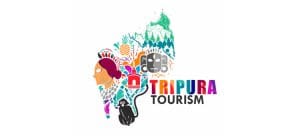
The official website is – http://tripuratourism.gov.in/
REFERENCE
https://www.paramparaproject.org/traditions_handloom-weaving-tripura.html
http://tripuratourism.gov.in/art-crafts
http://www.tripura.org.in/dishes.htm
https://www.utsavpedia.com/weddings-festivals/weddings-in-tripura/
https://www.tripuraonline.in/about/profile/culture/tribal-jewellery-of-tripura


